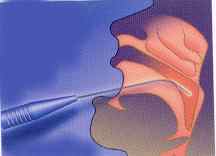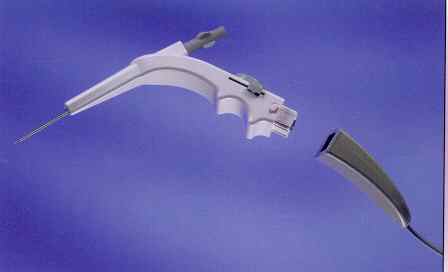
There are several causes of snoring, including a blocked nose, large tonsils, floppy tongue or obesity. These may be corrected following assessment by an ENT Surgeon or a dietician. In some patients, the snoring is due to excessive vibration of the soft part of the palate. In the past these patients have been helped by operations which have usually included removing a small part of the palate surgically or with a laser. Unfortunately these operations sometimes result in severe post-operative pain and a long recovery period. The technique of radiofrequency palatoplasty is associated with several important advantages, including much less post-operative pain, rapid return to work and the ability to perform the procedure under local anaesthetic as an out-patient.
Radiofrequency techniques
COBLATION RADIOFREQUENCY PALATOPLASTY
Radiofrequency technology is a relatively new method of precise tissue removal carried out at much lower temperatures than usual electro-diathermy or laser. The radiofrequency energy is applied with a narrow 'wand' to the centre of the palate muscle and causes a small area of scar tissue which shrinks and stiffens. This recently introduced procedure reduces the vibration of the palate in patients who have severe snoring. The technique known as ‘Coblation Radiofrequency Palatoplasty’ is available in an increasing number of centres in the UK.
Technique
The procedure
is normally carried out under local anaesthetic although
a general anaesthetic may be given if the patient has an
extremely sensitive throat and a tendency to gag.
The palate is numbed by a spray and local injection.
The special electric probe is then inserted into the soft
palate and the current activated for a few seconds. This causes a
very localised removal of tissue with minimal heat damage
to adjacent structures. The resulting scar
gradually contracts and stiffens the palate during the
following weeks. The patient is monitored for
a couple of hours after the procedure and then allowed
home with a supply of simple pain killers.
This causes a
very localised removal of tissue with minimal heat damage
to adjacent structures. The resulting scar
gradually contracts and stiffens the palate during the
following weeks. The patient is monitored for
a couple of hours after the procedure and then allowed
home with a supply of simple pain killers.
The majority of patients have reported minimal pain following the procedure and have been able to return to normal activities including work within 3 days.
There is naturally a small amount of swelling of the palate shortly after the procedure and this may make the snoring temporarily worse for a few days. Normally the swelling settles quickly after sucking crushed ice.
Results so far have been promising with most patients reporting an improvement in the level of snoring within 8 to 12 weeks. A repeat procedure is sometimes recommended in order to gain maximum benefit.
The long-term results for this technique are obviously still unknown but many patients report benefit lasting for a year or more. The procedure can then be repeated as appropriate.
Patient selection Radiofrequency palatoplasty is not suitable for all patients with snoring. Patients usually need to have a video or tape recording of their snoring before undergoing the treatment. This is to help decide if the snoring noise is indeed caused by a floppy palate. Some patients require a detailed overnight sleep study to exclude problems such as ‘Obstructive Sleep Apnoea Syndrome’, in which the patient often struggles to breathe and may hold their breath for a long time. Patients with blockage of the nose or enlarged tonsils will need to have this corrected before the radiofrequency palatoplasty operation can be effective.
Patients require referral from their General Practitioner prior to treatment. Private medical insurance companies will not reimburse the cost of treatment to the palate for snoring.
Somnoplasty
A similar technology is used in the technique known
as somnoplasty.  A fine electric probe is
inserted in the soft palate and the radiofrequency
current activated for two or three minutes to cause
volumetric reduction in the bulk and stiffening of the
soft tissue of the palate.
A fine electric probe is
inserted in the soft palate and the radiofrequency
current activated for two or three minutes to cause
volumetric reduction in the bulk and stiffening of the
soft tissue of the palate.
Coblation turbinate reduction
Radiofrequency techniques can also be applied to
shrink excessive volume in enlarged nasal turbinates.
Under local anaesthetic or a light general anaesthetic
the radiofrequency probe is inserted deep into the fleshy
turbinate and the current activated. The resulting lesion
contracts over the following 6 - 8 weeks and leads to a
reduction in the tubinate volume with subsequent increase
in nasal airflow.